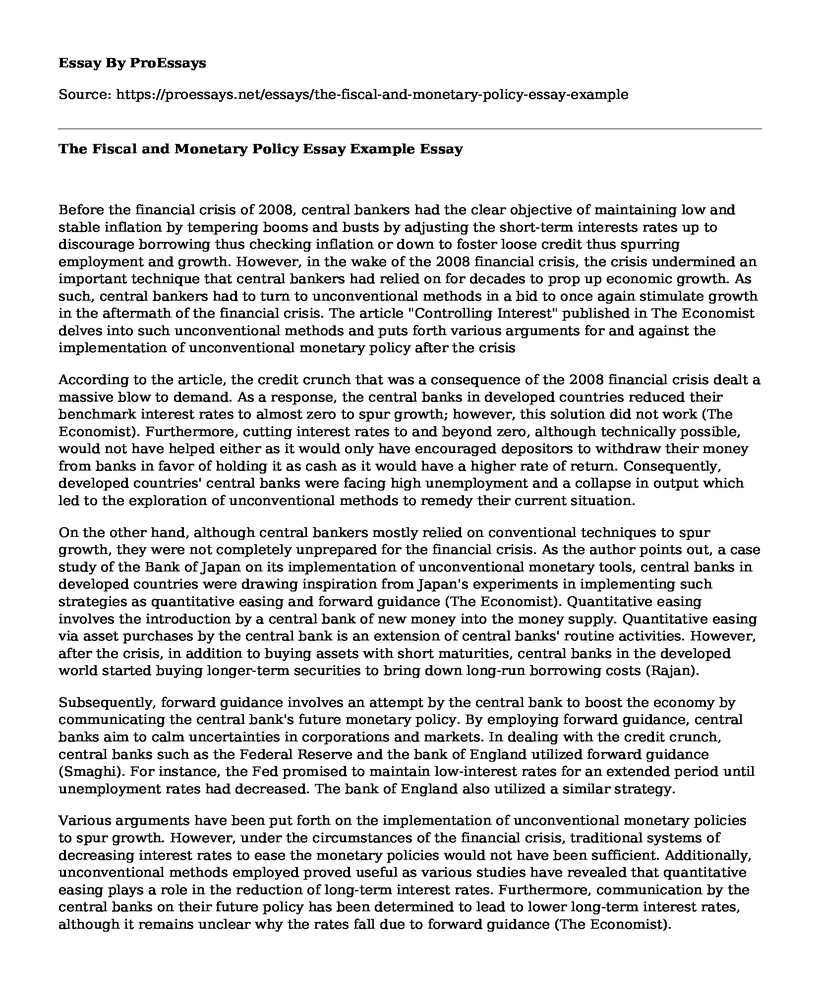Before the financial crisis of 2008, central bankers had the clear objective of maintaining low and stable inflation by tempering booms and busts by adjusting the short-term interests rates up to discourage borrowing thus checking inflation or down to foster loose credit thus spurring employment and growth. However, in the wake of the 2008 financial crisis, the crisis undermined an important technique that central bankers had relied on for decades to prop up economic growth. As such, central bankers had to turn to unconventional methods in a bid to once again stimulate growth in the aftermath of the financial crisis. The article "Controlling Interest" published in The Economist delves into such unconventional methods and puts forth various arguments for and against the implementation of unconventional monetary policy after the crisis
According to the article, the credit crunch that was a consequence of the 2008 financial crisis dealt a massive blow to demand. As a response, the central banks in developed countries reduced their benchmark interest rates to almost zero to spur growth; however, this solution did not work (The Economist). Furthermore, cutting interest rates to and beyond zero, although technically possible, would not have helped either as it would only have encouraged depositors to withdraw their money from banks in favor of holding it as cash as it would have a higher rate of return. Consequently, developed countries' central banks were facing high unemployment and a collapse in output which led to the exploration of unconventional methods to remedy their current situation.
On the other hand, although central bankers mostly relied on conventional techniques to spur growth, they were not completely unprepared for the financial crisis. As the author points out, a case study of the Bank of Japan on its implementation of unconventional monetary tools, central banks in developed countries were drawing inspiration from Japan's experiments in implementing such strategies as quantitative easing and forward guidance (The Economist). Quantitative easing involves the introduction by a central bank of new money into the money supply. Quantitative easing via asset purchases by the central bank is an extension of central banks' routine activities. However, after the crisis, in addition to buying assets with short maturities, central banks in the developed world started buying longer-term securities to bring down long-run borrowing costs (Rajan).
Subsequently, forward guidance involves an attempt by the central bank to boost the economy by communicating the central bank's future monetary policy. By employing forward guidance, central banks aim to calm uncertainties in corporations and markets. In dealing with the credit crunch, central banks such as the Federal Reserve and the bank of England utilized forward guidance (Smaghi). For instance, the Fed promised to maintain low-interest rates for an extended period until unemployment rates had decreased. The bank of England also utilized a similar strategy.
Various arguments have been put forth on the implementation of unconventional monetary policies to spur growth. However, under the circumstances of the financial crisis, traditional systems of decreasing interest rates to ease the monetary policies would not have been sufficient. Additionally, unconventional methods employed proved useful as various studies have revealed that quantitative easing plays a role in the reduction of long-term interest rates. Furthermore, communication by the central banks on their future policy has been determined to lead to lower long-term interest rates, although it remains unclear why the rates fall due to forward guidance (The Economist).
Conclusion
In conclusion, although unconventional methods are not favored to stimulate growth, they were they were the necessary solution required in the wake of the financial crisis. On the other hand, unconventional methods are not working as well as the traditional techniques as after the financial crisis, developed countries' economies even though economist cannot agree on why they are not working.
Works cited
Rajan, Raghuram. "A step in the dark: unconventional monetary policy after the crisis." 23 June 2013. Bank for International Settlements (BIS). 17 November 2018 <https://www.bis.org/events/agm2013/sp130623.htm>.
Smaghi, Lorenzo Bini. "Conventional and unconventional monetary policy." 29 April 2009. European Central Bank. 17 November 2018.
The Economist. "Controlling interest." 21 September 2013. The Economist. 17 November 2018 <https://www.economist.com/schools-brief/2013/09/21/controlling-interest?fsrc=rss>.
Cite this page
The Fiscal and Monetary Policy Essay Example. (2022, Oct 03). Retrieved from https://proessays.net/essays/the-fiscal-and-monetary-policy-essay-example
If you are the original author of this essay and no longer wish to have it published on the ProEssays website, please click below to request its removal:
- Foreign Exchange Theories
- Paper on Medical Insurance Terms
- Ministry Model and Leadership Styles Paper Example
- Essay Example on Police Officers: Essential Characteristics for Quality Service Delivery
- Amazon: A Premier Employer Despite Challenges in HR Recruiting - Essay Sample
- Essay Example on Rising Cost of Healthcare: The Need for Innovative Solutions
- Donald Trump & Mike Pence: Popular in Social Media - Essay Sample







